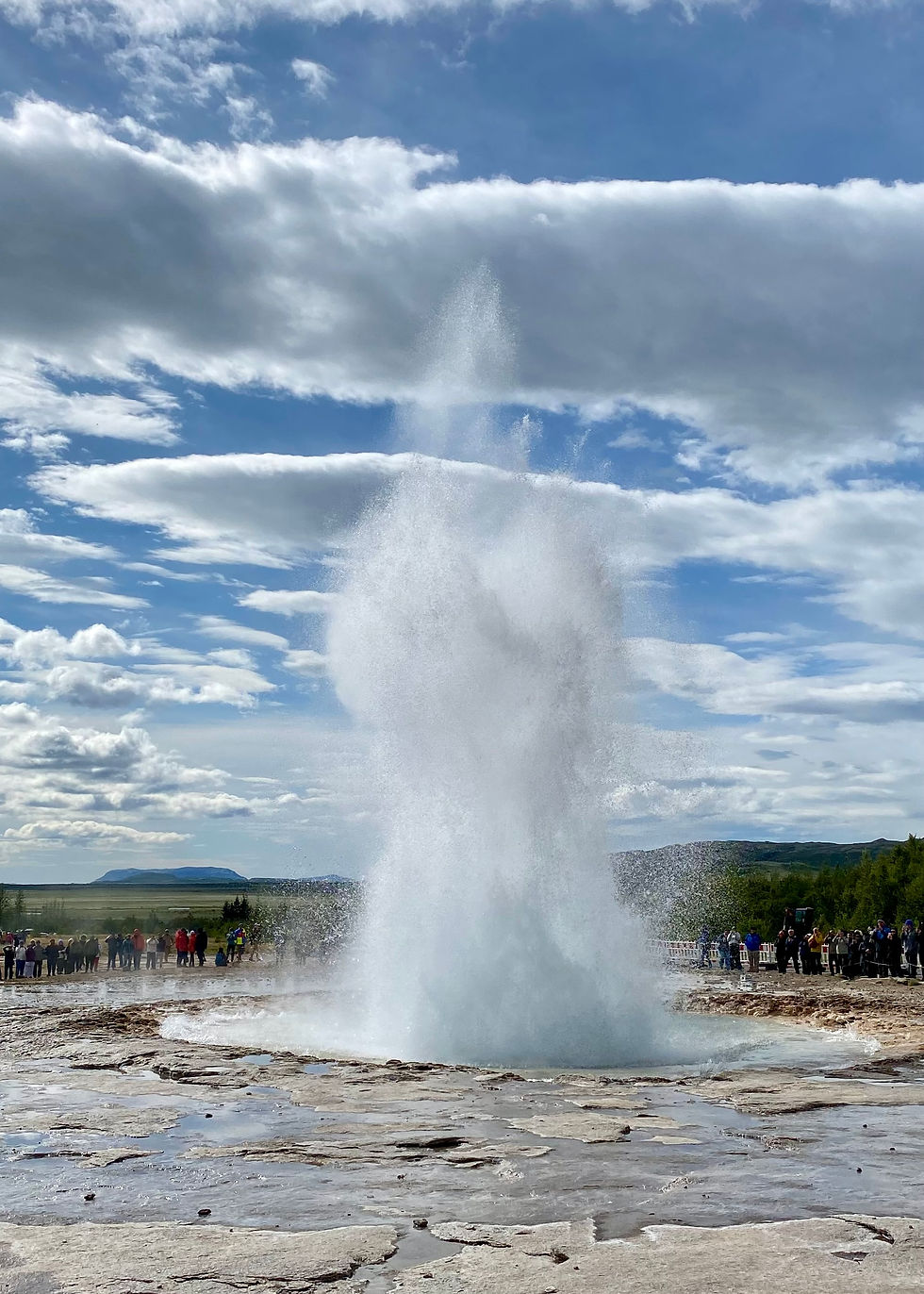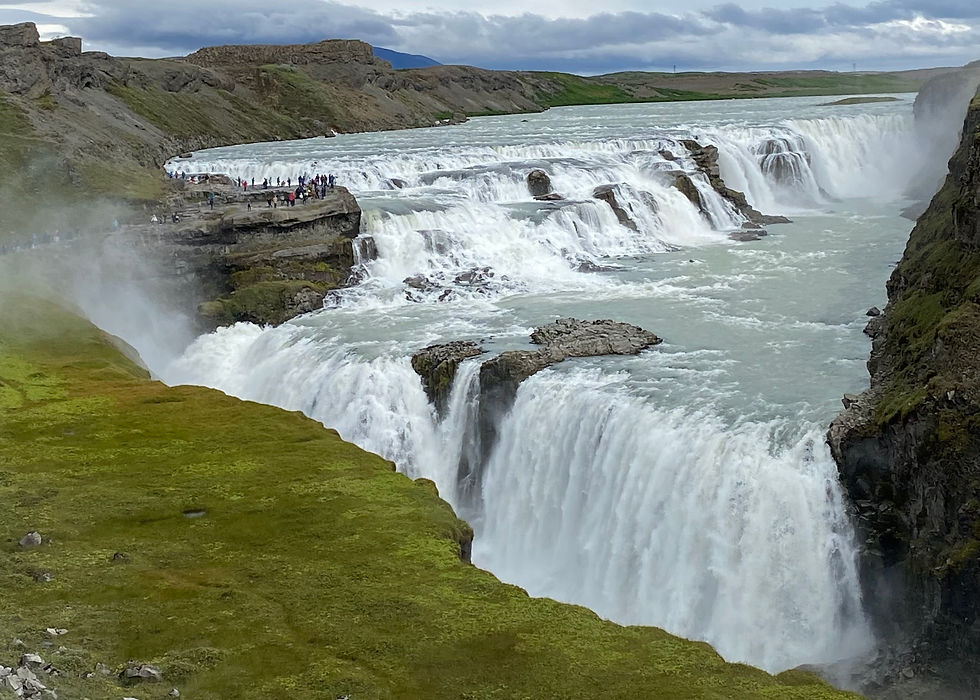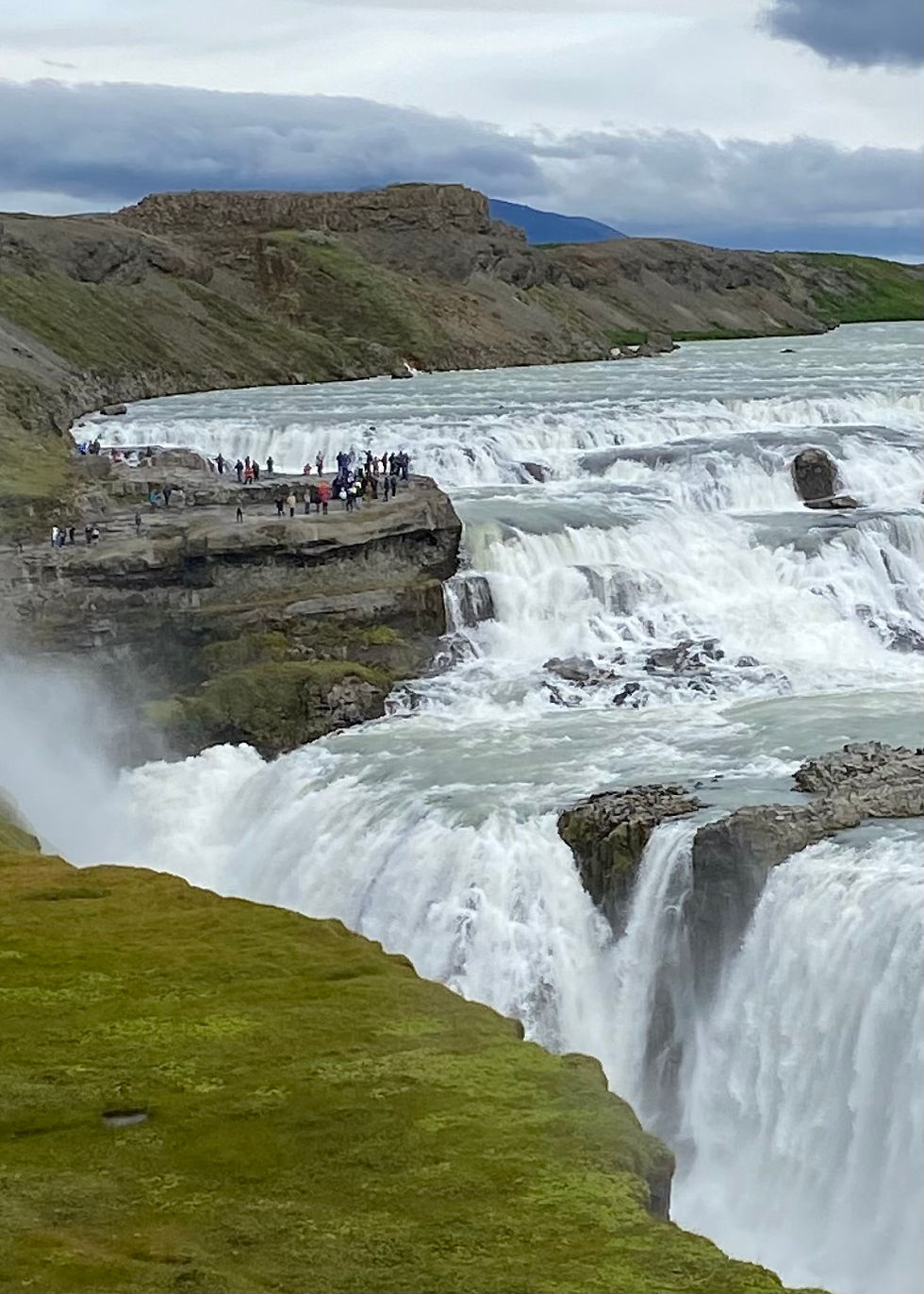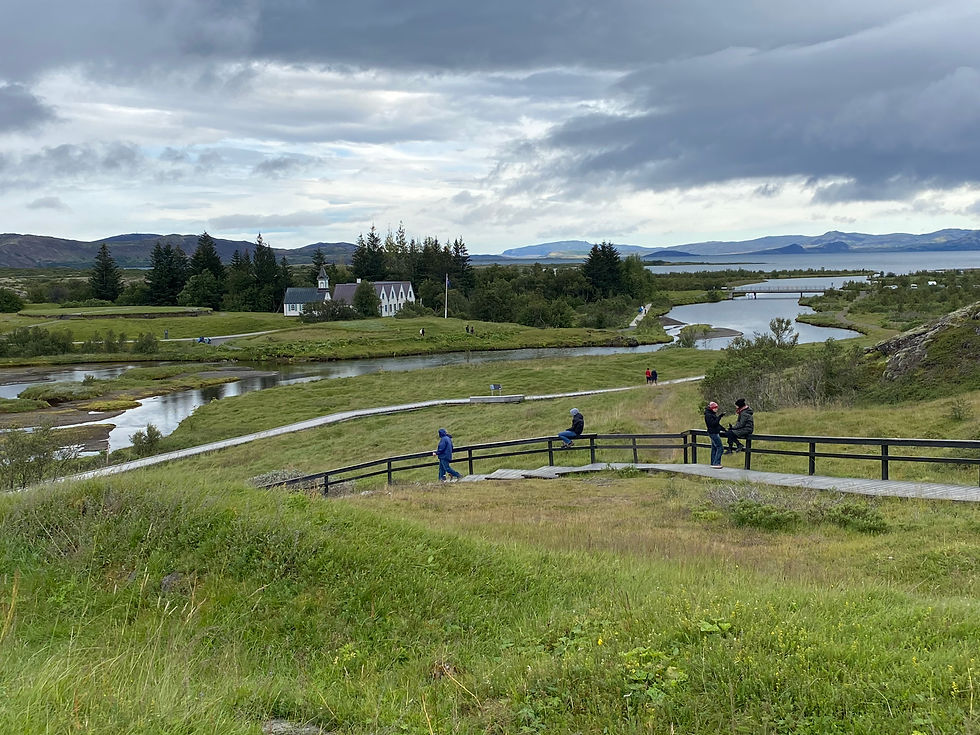August 22, 2024–Reykjavik, Iceland (day one)
- mlchad147
- Aug 23, 2024
- 8 min read

Well, last evening was certainly interesting. We sailed through waves of up to 33 feet and category one hurricane force winds, and had to deviate our course a bit to avoid even worse conditions, putting us an hour behind schedule in arriving in Iceland. By this morning we were well past the worst of it, though there was still some question as to whether we’d be able to safely dock in Reykjavik. Happily we were able to do so, and were able to connect with our 10:15 excursion right on time.
Reykjavik is the capital of Iceland and its largest city, with 140,000 residents, more than a third of the country’s total population. However, our excursion today was aimed at getting out and seeing a little bit of the island. And here’s a fact you may not know, but which is a big deal. The island is split almost down the middle by the dividing line between two tectonic plates, the North American and the Eurasian. These plates are slowly pulling the island apart, a few centimeters per year, and seeing the rift created by that action is one of the things I really wanted to do.
By the way, this tectonic separation is only partially related to Iceland’s volcanic activity. The island also sits on top of a hotspot, the Icelandic Plume, where a large pool of molten lava is close to the surface. This combination of tectonic movement and the lava hotspot creates a witches brew of geologic activity. Quite a place, Iceland.
But back to our excellent excursion, which I have delayed too long in describing. We opted for what’s known as the Golden Circle tour, which is by far the most popular one-day tour in Iceland. it’s an all day tour, especially if you include a lunch stop, which we did. The tour is a 190 mile loop that hits three spectacular natural wonders, along with providing a great look at the countryside along the way.
Our first stop wasn’t at one of the big three, but it was fascinating anyway. The Geothermal Exhibition at the Hellisheiðarvirkjun Power Plant was really well done and provided a lot of great information on geothermal energy in terms that even I could understand. Simply, they’ve drilled down to volcanically heated water and are using the steam from it to generate electricity and the hot water from it to pipe to Reykjavik. One hundred percent of Iceland’s electricity comes from geothermal or hydroelectric power, and the cost of electricity in Iceland is less than half of the average cost in the European Union. Talk about using your resources.
Then it was time for the big three, starting with Haukadalur, a geothermal hot spot that is home to mud pots, hot springs, fumaroles and two famous geysers. Geysir is probably the more famous of the two because it’s the one that gave geysers their name. It was a big geyser, but now it is unfortunately dormant and sometimes goes years without erupting. The second geyser, Strokkur, on the other hand, erupts every eight to ten minutes, putting on a wonderful show for the visitors who circle around it. We stayed long enough to watch it erupt several times, and I absolutely loved it.
Then we were off to Gullfoss (Golden Falls), a gorgeous two step waterfall that plunges a total of 105 feet while pouring an impressive 5000 cubic feet of water per second down its narrow canyon. The water source is the Hvitá River, which originates at a glacier 40 kilometers away. The sound of the falls was thunderous, and the wind driven spray coated my glasses at quite a distance. There were paved trails at different levels, and you could get very close (and very wet) if you wished, which we did not. I doubt that my photos will do it justice, but take my word for it, Gullfoss is great.
There’s a restaurant on site to accommodate the large numbers of visitors, and this was our lunch stop, included with the tour. We were served a delicious family style two course meal of tomato soup and Icelandic salmon, which really hit the spot after a few hours out in the cold and windy weather. And this would be a good time to mention the weather in Iceland, which is incredibly changeable due to the relentless winds that blow across the island. Iceland is the windiest country on Earth, and it’s not uncommon to experience all four seasons in a single day. They have a saying here that Iceland doesn’t have seasons, it has examples of seasons. Two things that didn’t change on our eight hour tour were the wind and the cold temperature. For much of the day the thermometer reading was in the low 40s, and the strong wind put the wind chill at a bracing 30. In August. Let me repeat that, in August. Be prepared if you come.
The third of the big three wonders on the Golden Circle tour is truly unique, so unique that according to our guide there’s no other place like it on earth. As I wrote in paragraph two above, Iceland lies directly atop the spot where two of the planet’s tectonic plates meet, and those plates are pulling the island apart at the rate of two centimeters per year. This has been going on for many thousands of years, so the gap is pretty wide, creating a rift valley. Icelanders are comforted by the fact that their island will never be pulled completely apart because eventually the widening gap will be filled in by the lava lurking below. No problem, right?
Anyhow, our stop was at a national park where the rift between the two tectonic plates is particularly dramatic, and there was a mostly gravel path that allowed us to walk down between the two continents, North America on our left and Europe on our right. The rift valley is very pretty, with a waterway running through it, and I enjoyed the view, but for me the big was just the idea of being somewhere and doing something that can’t be seen or done anywhere else on earth. It was very cool.
After that it was back on the bus for the 45 minute ride back to the port in Reykjavik, where we arrived at about 6:30 pm. Ordinarily that would have been it for the day, but there was some unexpected excitement after we were back on the ship. Not far from Reykjavik lies the small town of Grindavik, which has been plagued by nearby volcanic activity since last December, requiring the town to be evacuated. You may have heard about it when it first happened, because it was in the news a lot. The famous Blue Lagoon, a huge tourist attraction, is also nearby, and some of the ship’s passengers were out there bathing in its waters today.
Well, this afternoon the volcano erupted again with some magnitude along a 2.4 mile long fissure, forcing the immediate closure of the Blue Lagoon, the evacuation of the area, and the closure of all nearby roads. Happily, everyone made it out safely. How close was all this to Reykjavik? By car, less than 40 miles, and a good deal closer as the crow flies. After dark there was an orange glow in the sky, which Michele was able to photograph, and I’ll share her photo below.
Quite an ending to an epic day in the land of fire and ice, as the Icelanders like to call it. Iceland is stunningly beautiful, and is near the top of the countries we’ve seen that I would recommend to others as a place to visit. There’s just one aspect of the island that left me more saddened than I would have expected. We learned that when men first discovered and settled Iceland it was more than 40 percent forested, basically all of the island that wasn’t covered by snow and ice, too steep and rugged to support tree growth, or erased by volcanoes. Today only 1.2 percent of Iceland is forested, the rest deforested by humans, first to build homes and ships, and later to clear land for farming or grazing. Looking across vast stretches of barren, moss or grass and scrub covered open land was a little depressing when I thought of what it used to be. The government has a program to increase the amount of forest land to 12 percent by 2110, which says something about how difficult that will be. I hope they succeed.
That’s it for day one in Iceland. Tomorrow we’re scheduled to go whale watching, though unless the wind and seas calm down between now and then I have my doubts that the excursion will take place. Better have a Plan B, right? Whatever we do I’ll be back with a full report, so stay tuned.

At the geothermal plant, where they use heat from a nearby volcano to generate hot water for homes and businesses in Reykjavik and steam to power turbines that produce electricity.

Not surprising that there was a Tesla charging outside the geothermal plant. Electricity costs less than half as much in Iceland as the average cost in the European Union.

There are something like fifty species of moss in Iceland. It grows well where the forests used to be. That’s steam from the geothermal plant in the background.

Another typical scene as we drove along. The Golden Circle is 190 miles long, so we got to see a lot of the countryside.

It’s pretty, but…

Behind this sign is Geysir, the geyser that gave geysers their name.

This is Geysir. Though it hasn’t erupted in several years it’s only dormant. No one knows when the next one will be. When it does erupt though, it’s said to be pretty big.

Meanwhile, just a short distance away is Strukkur, which erupts regularly every eight to ten minutes. Here it is just starting to erupt.

And here it is at the peak of an eruption. For context, note the size of the people behind the geyser. We had enough time to watch it erupt several times.

So why not take a selfie while it was erupting. Did I mention that it was cold and windy?

On our way from the geysers to Gullfoss (the big waterfall) we passed this horse farm. Icelandic horses are a unique breed, and to protect the purity of the bloodline horses from other species cannot be imported to Iceland. In fact, even a purebred Icelandic horse that is taken from the country cannot return. How about that.

Another scene on the way to Gullfoss. A couple pretty bushes, but not a tree in sight, all the way to the distant mountains.

Iceland is not treeless, and scenes like this were common, as were thicker groves of pines.

Last one of these. Can you see the big glacier in the background?

This is Gullfoss. Note the people on the overlook.

A closer up view. It’s a two drop waterfall.

One more look. The wind was driving the spray all the way up here, and I had to take my glasses off and wipe the lens on my phone camera every time I wanted to take a photo.

There’s a popular story that the daughter of a former owner of the falls was instrumental in saving the falls from business interests that wanted to use it to build a hydroelectric power plant. The story has been more or less debunked, and it’s more likely that the investors simply ran out of money. Still, the lady is something of a heroine, and there’s a monument to her at the falls.

This beast was parked outside the restaurant at Gullfoss. I don’t know where its tours go, but wherever it is I think I’d like to go along.

We are standing on the edge of the North American tectonic plate, looking down into the valley that separates North America from Europe.

When the tectonic plates pull the two sides of the island far enough apart the underlying lava will fill in the valley, preventing Iceland from splitting in two.

Walking down into the valley that separates the two continents.

No idea what this stuff is, but it was pretty.

One more shot of the valley between North America and Europe. It’s quite beautiful.

If you’re ever fortunate enough to visit Iceland, do the Golden Circle tour. It’s a great way to see several of Iceland’s natural wonders.

And this is Michele’s photo taken from the deck of the ship showing the orange glow in the Reykjavik sky from the volcano erupting near Grindavik.


